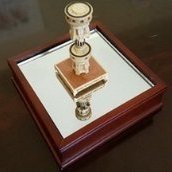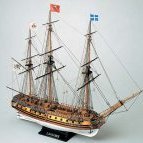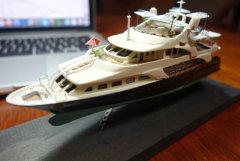MORE HANDBOOKS ARE ON THEIR WAY! We will let you know when they get here.
×
-
Posts
1,285 -
Joined
-
Last visited
Reputation Activity
-
 reklein got a reaction from Nirvana in US Brig Syren by reklein - Model Shipways
reklein got a reaction from Nirvana in US Brig Syren by reklein - Model Shipways
I'm wondering why this kit doesn't have laser cut pinrails.
-
 reklein got a reaction from GrandpaPhil in US Brig Syren by reklein - Model Shipways
reklein got a reaction from GrandpaPhil in US Brig Syren by reklein - Model Shipways
Well I completed the coppering and went on to some other stuff like the gunport lids, stern decoration and then got a start on the figurehead and head rails. I'm having a lot of fun.
-
 reklein got a reaction from Jim Rogers in US Brig Syren by reklein - Model Shipways
reklein got a reaction from Jim Rogers in US Brig Syren by reklein - Model Shipways
Well I completed the coppering and went on to some other stuff like the gunport lids, stern decoration and then got a start on the figurehead and head rails. I'm having a lot of fun.
-
 reklein got a reaction from zappto in US Brig Syren by reklein - Model Shipways
reklein got a reaction from zappto in US Brig Syren by reklein - Model Shipways
Well I completed the coppering and went on to some other stuff like the gunport lids, stern decoration and then got a start on the figurehead and head rails. I'm having a lot of fun.
-
 reklein reacted to Dan Vadas in Bismarck by Dan Vadas - FINISHED - GPM - 1:200 - CARD and PE
reklein reacted to Dan Vadas in Bismarck by Dan Vadas - FINISHED - GPM - 1:200 - CARD and PE
Thanks for that Grant .
I thought it might be time I posted some Progress pics. The fore and aft superstructures haven't been fixed to the main deck yet as I still have work to do on both of them and it's easier off the hull :
Danny
-
 reklein reacted to Vegaskip in Ship paintings
reklein reacted to Vegaskip in Ship paintings
The last one was The Searchers, this is The Rescuers. Breaches Bouy rescue, imaginary, not an actual rescue.
Jim
-
 reklein reacted to Vegaskip in Ship paintings
reklein reacted to Vegaskip in Ship paintings
Thanks John, this was more a sketch for a bigger pic which hasn't been done yet.
Anti Aircraft Cruiser HMS Scylla under attack from Ju88's
jim
-
 reklein reacted to Vegaskip in Ship paintings
reklein reacted to Vegaskip in Ship paintings
Schneider Trophey race 1929?
Old RN Destroyer used as a turn mark.
Supermarine S6 flown by H R D Waghorn wins at 328.63 mph
Italy represented by Macchi MR52R Flown by T Dal Molin
RMS Berengaria heading for Southampton.
-
 reklein reacted to Vegaskip in Ship paintings
reklein reacted to Vegaskip in Ship paintings
This one is from the period of the Falklands conflict.
L to R Glamorgan, Canberra, Endurance and Olna, with the Wessex 'Humphry' and Endurance's Wasp.
I don't know if they were ever in this formation, but I think they were all in the vicinity.
Jim
-
 reklein reacted to willz in Ship paintings
reklein reacted to willz in Ship paintings
great stuff, and so many. i used to paint pictures years ago but somehow i never really got the bug, i`ve painted about 25 in the last 45 years and none in the last 15 most i gave away. and i dont know why i just got bored, bit similar to my model building now, seem to have the skills but not the drive, of all my paintings only two were of ships, one i gave to an old friend that used to be in the merchant navy and the other i gave to my younger brother and his wife, i have a photo of this one, it was a picture i saw on a book cover in a second hand book store, so i bought the book for a few pence and painted it, the picture was done on a 30" x 20" board in oils, so here it is
-
 reklein reacted to Mahuna in Kathryn by Mahuna - FINISHED - 1:32 - Skipjack Based on HAER Drawings
reklein reacted to Mahuna in Kathryn by Mahuna - FINISHED - 1:32 - Skipjack Based on HAER Drawings
Part 29 – Log Rail
Kathryn’s sides above the waterway consist of a log rail topped by head rails. The log rail is a 5” x 5” timber, the headrails are 4” x 3” supported by iron stanchions. This entire configuration is painted white.
The forward log rails are doubled from a few feet forward of the dredge rollers to the knightheads, topped by a single head rail. The rails aft of the dredge rollers consist of the log rail topped by two head rails. The stanchions between these two aft head rails alternate in thickness, while the stanchions in the forward rails are a consistent thickness. This configuration can be seen in the following photos.
The different timbers of the rails would need to be shaped to match each other and drilled for stanchions so that the holes would align. Using the plywood template developed in an earlier post, rough drawings of each of the components of a rail were cut on the scroll saw and were then glued together using small spots of school glue, as in the following photos.
The line for the interior edge of the rail was an accurate depiction of that edge, and was used as the reference edge for the rest of the shaping. This edge was sanded to the reference line on the spindle sander.
A compass was then used to mark the thickness of the log rail on the outer edge of this assembly.
The assembly was then sanded to that outer edge line.
While all components were still glued together they were drilled to accept the stanchions. A table with a vertical peg (used in one of the early posts when shaping the keelson) was set so that the holes would be drilled a consistent distance from the inner edge.
After drilling was completed, the cap rail was separated from the assembly be gently tapping a razor blade through the glue joints.
Since the width of the cap rail is less than the width of the log rail, the width of the cap rail was marked using a compass, and the rail was then reduced to its final width using the disk sander.
The two pieces of the log rail were separated, and the upper rail was reduced in length.
The fit of the three pieces was tested, using filler blocks for the spacing.
The starboard side rails were then prepared.
The log rail needs to sit level on the waterway so that the stanchions would be vertical. To test this, the log rail was clamped to the hull and a brass rod was inserted in one of the holes.
The rod did not sit level, so the waterway was shaped using a rotary tool until it allowed the stanchions to sit vertically.
The lower log rail was pinned and glued to the hull, and then the second log rail was pinned and glued, using some brass rods to assure proper alignment.
After gluing the log rails the forward cap rails were temporarily installed.
Since this seemed to achieve a good result, work continued on the remainder of the log rails. The next section ran from the end of the first section to the round section in the stern, and consisted of the log rail and two cap rails. The complex arrangement of the stanchion holes can be seen in the following photo.
The log rail was pinned and glued.
The log rail and the two cap rails for the rounded stern were prepared in the same way.
The log rail is now fully installed. The cap rails will be left for a much later time. I’m afraid that installing them too soon would make some of the remaining work (deck planking, etc) more difficult and would present a risk to the cap rails.
The following photos show Kathryn’s current state.
Sorry for the very long post, but it was a fairly complex subject for me. Thinking about how to install the log rails has been my sole focus for the past few days, so I’m not sure what task will be next. There are several items that are independent of each other, and I don’t think the sequence matters too much, so we’ll see what develops!
Thanks everyone for following this build – it has been a real education for me, and a very enjoyable experience so far.
-
 reklein reacted to Mahuna in Kathryn by Mahuna - FINISHED - 1:32 - Skipjack Based on HAER Drawings
reklein reacted to Mahuna in Kathryn by Mahuna - FINISHED - 1:32 - Skipjack Based on HAER Drawings
Part 27 – Guards and Waterway
Having returned from our road trip to Colorado and Nebraska, it’s back to work on Kathryn.
The first task is to install the outer stem. As shown in an earlier post, this timber has pegs inserted that allow it to be positioned against the inner stem, seating these pegs in holes that had been pre-drilled. The outer stem tapers from the edge of the hull planks to the cutwater, and rough shaping was done before attaching the stem.
Since clamps would not hold on the slanted surfaces, temporary pins were used to hold the timber in place. The small wood blocks prevent damage to the stem when the pins are hammered in place.
The shaping of the outer stem will be worked on as the rest of the hull preparation proceeds. Final shaping will wait until the Cutwater is installed.
Kathryn, as in most other Skipjacks, has guards installed on the hull. These guards reach from approximately the forward hatch to just aft of the cabin. The guards are tapered – on the model the guards are 1/8” thick against the hull, and taper to 3/32” on the outer edge. The stock for the guards was tapered by hand prior to installation, and then the guards were soaked in boiling water and clamped to the hull for drying.
The guards taper in the forward and aft ends. The following photo shows the starboard guard (bottom of the photo) already tapered, and the port guard awaiting tapering.
After drying for 8 hours, followed by the fore and aft tapering, the guards were glued to the hull.
Holes for functional bolts (1/32” brass rod) were pre-drilled before the guards were glued in place. Once the guards were in place, the hull was drilled to accept the bolts, and then the bolts were glued in place using medium viscosity CA.
The following photos show the aft taper of the port guard and the forward taper of the starboard guard.
The next task was to make the waterway, which is the lower part of the log rail. A template was made from 1/32” plywood in order to facilitate measuring and shaping of these components.
The forward section of the waterway, from the knightheads to the area of the mast, are tapered. The width of the waterway at the knightheads is 7”, and this increases to 10” at the mast. The 10” width is then continued for the rest of the waterway. The following photo shows the forward section of the waterway after initial shaping.
The waterway is flat in the area of the log rail – the outside 4 inches – and is 4 inches thick in that area. It then tapers to deck plank thickness (1-3/4”) on the interior edge. A compass was used to mark the outside edge for the log rail.
And then was used to mark the plank thickness.
The water way was shaped using a rotary tool and sanding blocks.
The forward section of waterway needed to be pinned in place, since clamps would not work.
The rest of the waterway sections could be held in place using clamps.
Since the model will be painted I did not use scarf joints to join the sections.
The aft section of the waterway and log rail do not extend all the way to the transom – they are curved just forward of the transom.
There is still a lot of cleanup (scraping and sanding) prior to painting, but the log rail and some other items need to be installed before the cleanup can be completed.
The following photos show the current status of the model.
Next up is completion of the log rail, which will be the subject of the next post.
-
 reklein got a reaction from Canute in When Clamps Don't
reklein got a reaction from Canute in When Clamps Don't
Have you tried using Kicker ? Its a product that comes in a little spray bottle and when applied to the joint causes CA to set promptly. I do not usually spray it but use the pickup tube as an applicator to avoid overspray and waste. CA sets in the absence of oxygen so that what the Kicker does then quickly evaporates.
-
 reklein reacted to Mirabell61 in Eagle of Algier 1753 by Mirabell61 - FINISHED - 1:48 - Chebec - Nils Langemann
reklein reacted to Mirabell61 in Eagle of Algier 1753 by Mirabell61 - FINISHED - 1:48 - Chebec - Nils Langemann
Update :...
fitted decore fries and handrail on the stb. poop deck. The solution with the soldered brass pins works out quite well....
Also fitted a handrail all around the gun deck
Nils
the mermaid is holding a starfish in hands. What looks like she is having two horns are the remains of the charms hanging / holding loop. I use this for fastening the top to the cap rail...., providing more stiffnesss
-
 reklein reacted to SJSoane in HMS Bellona 1760 by SJSoane - Scale 1:64 - English 74-gun - as designed
reklein reacted to SJSoane in HMS Bellona 1760 by SJSoane - Scale 1:64 - English 74-gun - as designed
Santa did not bring a soldering iron or heat gun for me this year, so I turned again to the steam box parts that I had purchased a few years ago. I built a new box out of PVC pipe, scaled down to the sizes of wood I need to bend. I tried one former that was not sharp enough bend to allow for the springback, and then modified the bend more sharply to compensate (see sketch below). The final bend came out just right. I am in business!
Mark
-
 reklein reacted to Jim Lad in Bismarck by Dan Vadas - FINISHED - GPM - 1:200 - CARD and PE
reklein reacted to Jim Lad in Bismarck by Dan Vadas - FINISHED - GPM - 1:200 - CARD and PE
Very professional looking launches, Danny. It must have been a lot of fun manoeuvring those to centre ones in and out of their stowage positions.
By the way, can we see a photo of that mast platform with the VW in situ, please.
John
-
 reklein got a reaction from mtaylor in Hello from Turkey
reklein got a reaction from mtaylor in Hello from Turkey
Welcome aboard 007! Hope you find us worthy.
!
-
 reklein reacted to Padua007 in Hello from Turkey
reklein reacted to Padua007 in Hello from Turkey
Hi,
I am german and currently working / living in Turkey. 53 years young and I love ships.
Schoner and Tallships my favorites, but I have as well a look on all old sailing vessels.
I made an apprenticeship as mechanical and a study as industrial engineer.
With some interruptions I am making ship models for 20 years.
Everytime with RC and from a kit.
Now I am trying on models based on drawing and without RC.
I enter in MSW to see, unterstand and to learn from you all.
-
 reklein got a reaction from Omega1234 in T78 Norden by popeye the Sailor - FINISHED - Billing Boats - 1:30
reklein got a reaction from Omega1234 in T78 Norden by popeye the Sailor - FINISHED - Billing Boats - 1:30
The winch on those boats look a lot like the Alaska gill netter boats used on the Northern rivers for salmon.
-
 reklein got a reaction from popeye the sailor in T78 Norden by popeye the Sailor - FINISHED - Billing Boats - 1:30
reklein got a reaction from popeye the sailor in T78 Norden by popeye the Sailor - FINISHED - Billing Boats - 1:30
The winch on those boats look a lot like the Alaska gill netter boats used on the Northern rivers for salmon.
-
 reklein got a reaction from popeye the sailor in USS Carl Vinson by Wolfman_63 - FINISHED - Trumpeter -1/350 - PLASTIC - Conversion of Nimitz Kit
reklein got a reaction from popeye the sailor in USS Carl Vinson by Wolfman_63 - FINISHED - Trumpeter -1/350 - PLASTIC - Conversion of Nimitz Kit
This is a GREAT build. Keep up the good work.
-
 reklein got a reaction from EJ_L in Hello gentleman,,, I am a new member ,,
reklein got a reaction from EJ_L in Hello gentleman,,, I am a new member ,,
Welcome aboard Jaan. I have known only one other person with the name Ojala,and he lived in Sitka Alaska for many years and now lives in Hawaii.Just an interesting,to me ,tidbit.
-
 reklein got a reaction from mtaylor in T78 Norden by popeye the Sailor - FINISHED - Billing Boats - 1:30
reklein got a reaction from mtaylor in T78 Norden by popeye the Sailor - FINISHED - Billing Boats - 1:30
The winch on those boats look a lot like the Alaska gill netter boats used on the Northern rivers for salmon.
-
 reklein got a reaction from John Allen in T78 Norden by popeye the Sailor - FINISHED - Billing Boats - 1:30
reklein got a reaction from John Allen in T78 Norden by popeye the Sailor - FINISHED - Billing Boats - 1:30
The winch on those boats look a lot like the Alaska gill netter boats used on the Northern rivers for salmon.
-
 reklein got a reaction from mtaylor in Kits with fewer Cast Metal parts.
reklein got a reaction from mtaylor in Kits with fewer Cast Metal parts.
If you carve your own parts and then cast them from your own originals the parts are still considered original work. Its not too difficult to cast resin parts and theres a ton of material on how to on the net. But I agree that a lot of the metal kit parts are a little crude. The General public will probably not notice the difference though.










